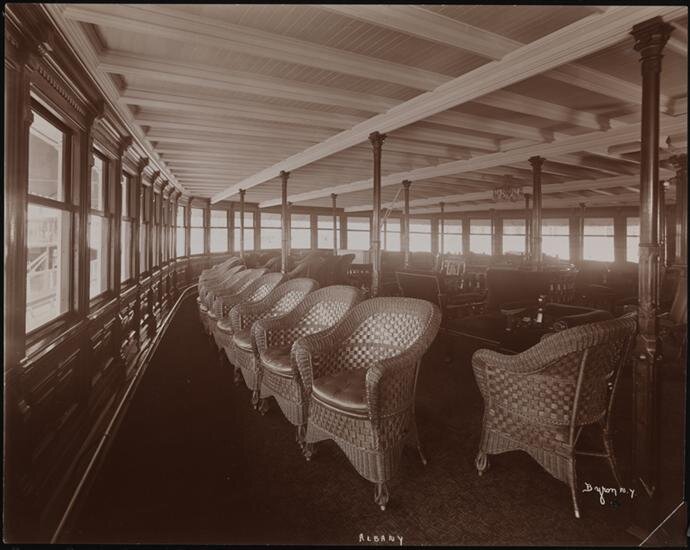The Hudson-Athens Lighthouse and the Golden Age of Day Line Steamers
A map showing the route of the steamboats
From weekend kayakers to massive cargo ships fresh from the Atlantic Ocean, the Hudson-Athens Lighthouse sees a diverse array of marine traffic. However, one form of transportation that is no longer visible on the Hudson River is steamboats. From the 1860s to the 1940s, the Hudson-Athens Lighthouse provided safe passage for millions of steamship travelers.
A postcard featuring the Lighthouse and the steamboat Albany. Image courtesy of the Vedder Research Library.
The most famous steamboat line, the Hudson River Day Line, was founded in 1863, just 10 years before the construction of the lighthouse. Their ships would ferry passengers between New York and Albany, with stops at towns along the way, including Yonkers, Poughkeepsie, and Hudson. The Hudson River Day Line prided itself on the size, speed, and elegance of its fleet. Steamers like the Albany were 300 feet long, could accommodate 1,500 passengers, and according to a 1930s timetable, completed the long journey upriver in 9 hours. Pretty reasonable timing if you forget Amtrak can do the same journey in two-and-a-half!
The Day Line attracted both day trippers, those who’d take the ship to riverside attractions like Bear Mountain State Park and catch another steamer home in the evening, as well as travelers heading to the Catskill Mountains region or Saratoga Springs via Albany for longer summer vacations. A round-trip to Albany would set you back $4.
A magazine clipping from 1924 advertising the new steamboat Alexander Hamilton, featuring a photograph of the Hudson-Athens Lighthouse
Unlike previous steamships that carried both people and freight, the Day Line steamers were strictly passengers only. This allowed the ships to be decked out (pun intended!) with a variety of amenities. The cabins were decorated with polished wood paneling and paintings by celebrated local artists. The dining rooms on the main deck featured extensive European-style menus (one order of “Fruit Fritters with Day Line Sauce” please! “Clysmic water” on the side). Performances by orchestras, writing rooms to fire off your postcards, newsstands, saloons, ladies parlors, smoking parlors, barber shops, and, apparently on one steamer, a darkroom for passengers to develop their own photographs, in case you got tired of the views.
But who could? Three tiers of outdoor decks and big wicker chairs inside were provided to encourage gazing at the Hudson scenery. A brochure published by the Day Line in the 1940s describes the atmospheric journey the steamers took past Hudson and the nearby Middle Ground Flats:
“Presently the steamer's whistle announces a landing at the old whaling port of Hudson. Then begins the northernmost leg of the journey. You sail past quaint lighthouses, and among wooded islands that give you the feeling of exploring a chain of lakes.”
The Robert Fulton with the Hudson-Athens Lighthouse in the distance
The Hudson-Athens Lighthouse was regularly featured in the Day Line’s promotional materials, including postcards, route maps, and the steamers’ version of an in-flight magazine. There is even a photograph of the lighthouse alongside the last steamship to ever run the Albany to New York City route: the Robert Fulton.
After a boom during World War II, the Day Line’s success declined. Travel by steamboat was just too slow and old-fashioned compared to your very own automobile. On September 13, 1948, the Robert Fulton returned to New York, ending the Golden Age of the Day Line steamers.
However, there are happy endings for both the lighthouse and the steamship. The Hudson-Athens Lighthouse is still fully functional, operated remotely by the U.S. Coast Guard and cared for by the Hudson-Athens Lighthouse Preservation Society. And the Robert Fulton? Well, she retired to the Bahamas in 1956.
Did you ever take trips on the abridged Hudson River Day Line (New York City to Poughkeepsie) in the 50s or 60s? We’d love to hear your story!




